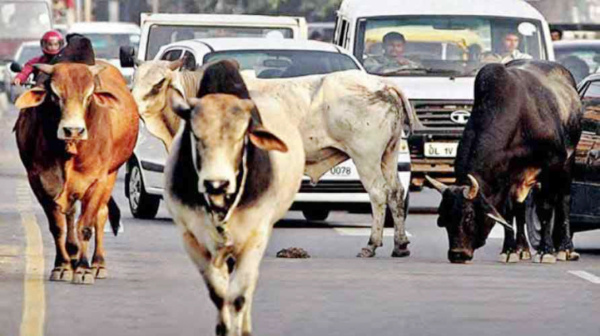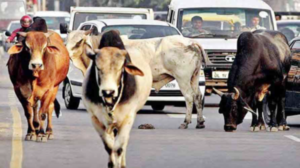आवारा मवेशी, घटिया दाम और कई मुद्दे aavaara maveshee, ghatiya daam aur kaee mudde


©प्रियंका सौरभ
परिचय- हिसार, हरियाणा.
आवारा मवेशी शहरी और ग्रामीण दोनों क्षेत्रों में मानव निवासियों और पशु कल्याण के लिए कई खतरे पैदा करते हैं। आवारा मवेशी खड़ी फसलों को खाने और मनुष्यों पर हमला करने के लिए जाने जाते हैं। कृषि उद्योग में बढ़ते मशीनीकरण ने भी मवेशियों को काम करने वाले जानवरों के रूप में उपयोग से बाहर कर दिया है, और मवेशियों के परित्याग के मामलों की संख्या में वृद्धि हुई है। गौरक्षकों द्वारा गिरफ्तारी, उत्पीड़न और लिंचिंग के डर ने भी मवेशियों के व्यापार को कम कर दिया है। एक बार जब गाय दूध देना बंद कर देती है, तो गाय को खिलाना और उसका पालन-पोषण करना उस किसान पर आर्थिक बोझ बन जाता है जो उसका भरण-पोषण नहीं कर सकता।
मनुष्य, जब से इसकी रचना हुई है, पृथ्वी पर कभी भी अकेला नहीं रहा है। जैसा कि हम सभी जानते हैं कि हम इस ग्रह को जीवों की विभिन्न प्रजातियों, जैसे कि जानवरों और पौधों के साथ साझा करते हैं। लेकिन भले ही हम सोचने, निर्णय लेने और अपने जीवन को कैसे जीना चाहते हैं, यह चुनने की क्षमता के कारण हम खुद को श्रेष्ठ प्रजाति का नाम देते हैं, हम बढ़ना शुरू कर देते हैं।
हमारा विकास कई अलग-अलग पहलुओं के बीच है, जैसे कि बुनियादी ढाँचा और जीवन शैली। इसने हमें किसी तरह इस तथ्य की उपेक्षा करने के लिए प्रेरित किया कि हम इस ग्रह पर अकेले नहीं हैं। हम अन्य प्रजातियों को रास्ते से हटाना शुरू कर देते हैं, और हमें कभी-कभी यह एहसास नहीं होता है कि उन अन्य प्रजातियों द्वारा महसूस किए गए प्रभाव के भयानक और कभी-कभी घातक परिणाम होते हैं, और हम कभी-कभी यह समझने में भी असफल होते हैं कि यह हमें नुकसान भी पहुंचा सकता है।
पशुधन जनगणना के आंकड़ों के अनुसार भारत में 5 मिलियन से अधिक आवारा मवेशी हैं। शहरी और ग्रामीण दोनों क्षेत्रों में मनुष्यों और फसलों पर आवारा गाय का हमला निवासियों के लिए एक मुद्दा है। आवारा मवेशी शहरी क्षेत्रों में यातायात के लिए एक उपद्रव हैं और अक्सर सड़क दुर्घटनाओं का कारण बनते हैं। गाय सड़क के बीच या किनारे या डिवाइडर पर बैठना पसंद करती है क्योंकि तेज गति से चलने वाला यातायात मक्खियों और कीड़ों द्वारा जानवर के शरीर से दूर हो जाता है, और जानवर को हर बार अपनी पूंछ हिलाने की आवश्यकता नहीं होती है। इस प्रकार उन्हें सड़कों पर बैठना/बैठना आसान, आरामदायक और आरामदायक लगता है। सड़कों पर बैठी इन आवारा गायों में से कई आसपास के गांवों में रहने वाले लोगों की हैं. आम बोलचाल में, आवारा मवेशियों में गाय, बैल या बछड़े शामिल होते हैं जिन्हें छोड़ दिया जाता है क्योंकि वे अनुत्पादक होते हैं।
अधिकांश भारत में गायों का वध अवैध है, क्योंकि गायों को हिंदू धर्म में पवित्र माना जाता है। वध विरोधी कानूनों को 2014 तक सख्ती से लागू नहीं किया गया था, जब भारतीय जनता पार्टी (बीजेपी) सत्ता में आई थी। इससे पहले, किसान नियमित रूप से अपनी बूढ़ी गायों को बूचड़खानों में ले जाते थे। 2014 से, उत्तर प्रदेश सहित भारत के 18 राज्यों में गोहत्या को अवैध बना दिया गया है। कृषि उद्योग में बढ़ते मशीनीकरण ने भी मवेशियों को काम करने वाले जानवरों के रूप में उपयोग से बाहर कर दिया है, और मवेशियों के परित्याग के मामलों की संख्या में वृद्धि हुई है। गौरक्षकों द्वारा गिरफ्तारी, उत्पीड़न और लिंचिंग के डर ने भी मवेशियों के व्यापार को कम कर दिया है। एक बार जब गाय दूध देना बंद कर देती है, तो गाय को खिलाना और उसका पालन-पोषण करना उस किसान पर आर्थिक बोझ बन जाता है जो उसका भरण-पोषण नहीं कर सकता। जिन मवेशियों को किसान बेचने में असमर्थ हैं, उन्हें अंततः भटकने के लिए छोड़ दिया जाता है।
यह ध्यान देने योग्य है कि मालिक अपनी उपयोगिता खो चुके मवेशियों को छोड़ देते हैं। इन मवेशियों को आवारा मवेशी कहा जाता है जो भोजन की तलाश में गलियों में घूमते हैं या गली के बीच में बैठे देखे जाते हैं क्योंकि उनके पास कोई जगह या आश्रय नहीं है। मवेशियों को तब तक आश्रय में रखा जाता है जब तक वे अपने मालिकों को लाभ प्रदान करते। यह अशुभ है कि जिन गायों और बैलों को देवताओं के रूप में पूजा जाता है, उन्हें त्याग दिया जाता है या उनकी उपेक्षा की जाती है। मवेशी एक महत्वपूर्ण संसाधन हैं, कृषि प्रणाली का समर्थन करते हैं, और इस तरह पोषण सुरक्षा में योगदान करते हैं। जनवरी 2020 में, केंद्रीय मत्स्य पालन, पशुपालन और डेयरी मंत्रालय ने 20 वीं पशुधन जनगणना जारी की थी, जिसमें कहा गया था कि भारत में 5 मिलियन से अधिक आवारा मवेशी हैं।
देश के कई राज्यों में पूरी मवेशी आबादी का लगभग 50% गैर-प्रजनन योग्य श्रेणी में है और इसे अनुत्पादक कहा जा सकता है। ” इन आवारा मवेशियों को छोड़ दिया जाता है, और उन्हें अपने दम पर अपना भरण-पोषण करना पड़ता है। सरकार द्वारा आवारा पशुओं के मुद्दे पर विचार करने के लिए समितियां नियुक्त करने और मवेशियों को छोड़ने के लिए कड़ी सजा के प्रस्ताव के बावजूद, अक्सर सुनसान मवेशियों के मालिकों को पहचानने के लिए यह असंभव पाया जाता है। इतना ही नहीं, सूखे, अकाल और बाढ़ जैसी आपदाओं से पीड़ित अपने पशुओं की तो बात ही छोड़िए, किसान मुश्किल से अपना भरण-पोषण कर पाते हैं। ऐसे मामलों में, उनके पास अपने गैर-आर्थिक मवेशियों को छोड़ने के अलावा कोई अन्य विकल्प नहीं बचा है। पिछले कुछ दशकों में, क्रॉसब्रीडिंग पर अत्यधिक ध्यान दिया गया है, और स्वदेशी लोगों की उपेक्षा की गई है। यह भी आवारा पशुओं की आबादी में योगदान करने वाले कारकों में से एक है।
आवारा मवेशियों की समस्या ज्यादातर शहरों में होती है क्योंकि ये चिंता का विषय तो बन ही जाते हैं और कई बार परिवहन व्यवस्था और आम जनता के लिए भी खतरा बन जाते हैं। हालांकि, गांवों में छोड़े गए मवेशी अपना पेट भरने के लिए फसलों पर छापा मारते हैं, जिससे फसलों और किसानों को नुकसान होता है। एक बार जब वे अयोग्य हो जाते हैं, तो उनका पालन-पोषण आर्थिक रूप से गैर-लाभकारी होता है। इस प्रकार, वे या तो पूरी तरह से वीरान हो जाते हैं या अपने मांस से मौद्रिक लाभ प्राप्त करने के लिए बूचड़खानों को बेच दिए जाते हैं। आवारा पशुओं की समस्या के समाधान के लिए सरकार कई बार हस्तक्षेप कर चुकी है।
आवारा पशुओं की समस्या के समाधान के लिए उन्हें गौशालाओं में रखना ही पर्याप्त और प्रभावकारी नहीं है। सरकार को इससे आगे देखने की जरूरत है और आवारा मवेशियों को पीड़ित होने से बचाने के साथ-साथ इन आवारा मवेशियों के कारण होने वाले खतरे से जनता को बचाने के लिए अन्य विकल्पों पर विचार करना चाहिए। लावारिस पशुओं की देखभाल के लिए राष्ट्रीय स्तर पर आवारा पशु बोर्ड गठित होना चाहिए। मात्र गौशालाएं स्थापित करना आवारा पशुओं की समस्या का समाधान नहीं है। सरकार को कृषि सीजन के दौरान किसानों को प्रति बैल रुपये का भुगतान करना चाहिए। यदि पशु-पालन को बढ़ावा दिया जाता है, तो लोग अपने पशुओं को नहीं छोड़ेंगे। इसके अलावा, अगर जानवरों को मालिक की जानकारी के साथ टैग किया जाता है, तो उन्हें उनके मालिकों के पास वापस खोजा जा सकता है।
साथ ही देश में जिस तरह से गौशालाएं काम कर रही हैं, उससे आवारा मवेशियों का क्या भला हो सकता है और किस हद तक। राष्ट्रीय गोकुल मिशन, सरकार की एक पहल भी, वांछित लक्ष्यों को प्राप्त नहीं कर पाई है। भारत की गोशालाओं और देशी नस्लों को समर्थन देने की एक पहल, हालांकि एक लाभप्रद कदम, इसे लागू करने के प्रयास में राज्य सरकारों की ओर से कमी रही है। इसलिए आवारा पशुओं की समस्या से निपटने के लिए मेनका गांधी की गौशाला नियमावली में की गई सिफारिशों को सरकार द्वारा सख्ती से लागू करने के प्रयास में लिया जाना चाहिए और इसके साथ ही सरकार को अन्य विकल्पों पर विचार करना चाहिए।

Stray cattle, substandard prices and many issues

©Priyanka Saurabh
Stray cattle pose several threats to human residents and animal welfare in both urban and rural areas. Stray cattle have been known to eat standing crops and attack humans. Increasing mechanization in the agricultural industry has also put cattle out of use as work animals, and has led to an increase in the number of cases of cattle abandonment. The fear of arrest, harassment and lynching by cow vigilantes has also reduced the cattle trade. Once the cow stops giving milk, feeding and rearing the cow becomes an economic burden on the farmer who cannot maintain it.
Man, ever since it was created, has never been alone on earth. As we all know that we share this planet with different species of organisms, such as animals and plants. But even though we name ourselves the superior species because of our ability to think, make decisions, and choose how we want to live our lives, we begin to grow.
Our development is intertwined with many different aspects, such as infrastructure and lifestyle. This somehow led us to ignore the fact that we are not alone on this planet. We begin to push other species out of the way, and we sometimes don’t realize that the impact felt by those other species has dire and sometimes fatal consequences, and we sometimes fail to understand. also fail that it can also harm us.
According to the livestock census data, there are more than 5 million stray cattle in India. Stray cow attack on humans and crops is an issue for residents in both urban and rural areas. Stray cattle are a nuisance to traffic in urban areas and often cause road accidents. The cow prefers to sit in the middle of the road or on the side or divider because the fast moving traffic is carried away from the animal’s body by flies and insects, and the animal does not need to wag its tail every time. Thus they find it easy, comfortable and comfortable to sit / sit on the roads. Many of these stray cows sitting on the roads belong to the people living in the surrounding villages. In common parlance, stray cattle include cows, bulls or calves that are abandoned because they are unproductive.
The slaughter of cows is illegal in most of India, as cows are considered sacred in Hinduism. Anti-slaughter laws were not strictly enforced until 2014, when the Bharatiya Janata Party (BJP) came to power. Earlier, farmers regularly took their old cows to slaughterhouses. Since 2014, cow slaughter has been made illegal in 18 states of India, including Uttar Pradesh. Increasing mechanization in the agricultural industry has also put cattle out of use as work animals, and has led to an increase in the number of cases of cattle abandonment. The fear of arrest, harassment and lynching by cow vigilantes has also reduced the cattle trade. Once the cow stops giving milk, feeding and rearing the cow becomes an economic burden on the farmer who cannot maintain it. The cattle that farmers are unable to sell are eventually left to wander.
It is worth noting that the owners abandon cattle that have lost their usefulness. These cattle are called stray cattle which roam the streets in search of food or are seen sitting in the middle of the street as they have no place or shelter. Cattle are kept in shelters as long as they provide benefits to their owners. It is inauspicious that cows and bullocks who are worshiped as gods are abandoned or neglected. Cattle are an important resource, supporting the agricultural system, and thus contributing to nutritional security. In January 2020, the Union Ministry of Fisheries, Animal Husbandry and Dairying released the 20th Livestock Census, which stated that there are more than 5 million stray cattle in India.
In many states of the country, about 50% of the entire cattle population is in the non-breedable category and can be termed as unproductive. These stray cattle are abandoned, and they have to maintain themselves on their own. Despite the government’s proposal to appoint committees to look into the issue of stray cattle and severe punishment for abandoning cattle, it is often found impossible to identify the owners of deserted cattle. Not only this, let alone their animals suffering from calamities like drought, famine and floods, farmers are hardly able to maintain themselves. In such cases, they are left with no option but to abandon their non-economic cattle. Over the past few decades, crossbreeding has received immense attention, and indigenous peoples have been neglected. This is also one of the contributing factors to the stray cattle population.
The problem of stray cattle occurs mostly in the cities as they become a matter of concern and sometimes they become a threat to the transport system and also to the general public. However, cattle abandoned in villages raid crops to feed themselves, causing damage to crops and farmers. Once they become ineligible, their upbringing is financially unprofitable. Thus, they are either completely deserted or are sold to slaughterhouses to gain monetary benefits from their meat. The government has intervened many times to solve the problem of stray animals.
To solve the problem of stray animals, keeping them in gaushalas is not enough and effective. The government needs to look beyond this and consider other options to save the stray cattle from suffering as well as save the public from the danger posed by these stray cattle. Stray Animal Board should be constituted at the national level to take care of the unclaimed animals. Mere setting up of cowsheds is not the solution to the problem of stray animals. The government should pay Rs. per bullock to the farmers during the agricultural season. If animal husbandry is encouraged, people will not abandon their animals. In addition, if animals are tagged with owner information, they can be traced back to their owners.
Also, the way gaushalas are functioning in the country, what good can happen to stray cattle and to what extent. Rashtriya Gokul Mission, also an initiative of the government, has not been able to achieve the desired goals. An initiative to support India’s cowsheds and indigenous breeds, though a profitable move, efforts on the part of state governments to implement it have been lacking. Therefore, to deal with the problem of stray animals, the recommendations made in the Gaushala Niyamali of Maneka Gandhi should be taken by the government in an effort to strictly implement it and at the same time the government should consider other options.
हिन्दू आस्थावान भय कब तजेंगे ? hindoo aasthaavaan bhay kab tajenge ?















